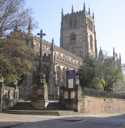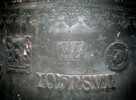For this church:    |
|
Henry Oldfield II |
Henry Oldfield II recast the fourth bell in 1595. This bell has survived all subsequent restoration and is the eleventh of the twelve bells now in existence. At 20¾ cwt, it is the largest surviving bell by the Oldfield firm. Decoration covers the shoulder and soundbow, and on the waist it displays the Royal coat of arms alternating with his own large foundry badge that Oldfield reserved for important commissions. The bell frame was replaced in 1625 and the tenor recast in 1637 by another Oldfield at the Long Row foundry, George I, the son of Henry Oldfield II.
John Crow replaced the 1625 bell frame again in 1699 when the bells were augmented from five to six. The new bell frame was installed 22 feet lower in the tower than the old one. The lower bell frame allowed the bells to swing full circle to accommodate the new and developing art of ringing changes. A geometric ringing platform built in the tower crossing in 1708 shortened the length of rope even more and put the ringers in full view of the congregation.
The tenor bell became cracked and Thomas Hedderly recast it in 1757. Hedderly had taken over the Nottingham Long Row foundry from the Oldfields in 1742. This period saw a spate of restoration work. In 1760 the bells were augmented to eight by the addition of two smaller bells. A new frame was built to accommodate the eight bells and, with minor modification, the frame survived until 1934.
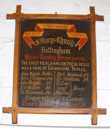 One
of the peal One
of the pealboards, this dating from 1761 |
The coronation of King George III in 1761 was celebrated by augmenting the bells from eight to ten by the addition of two trebles cast by Pack & Chapman of Whitechapel, London. The money for these bells was raised by public subscription.
It is also at around this time that the ringers in Nottingham formed themselves into the Society of Sherwood Youths, which society has continued to the present day. The bells however, were not completely satisfactory; the third, fourth and tenor went to Lester & Pack in London for recasting. The resultant bells appeared to be satisfactory and the Society of Sherwood Youths rang a series of long peals on the bells culminating in 10,260 changes of Grandsire Caters rung in 7 hours 22 minutes on 3rd March 1778. This was conducted by William Doubleday Crofts, who rang the ninth bell single-handedly throughout. This series of peals was the result of competition between Leicester ringers and those of Nottingham in attempting to ring 10,000 changes. Leicester won with 10,080 changes of Grandsire Caters in February 1777, but the Nottingham peal was longer. Both sets of ringers were presented with a set of hand bells.
The geometric ringing platform under the tower crossing was dismantled in 1812 and the ringers returned to the loft above the plaster and oak vaulting.
The Nottingham Review reported on 25th July 1845:
We hear that the treble bell, in the fine peal at St Mary’s church, was broken on Sunday week, through the unskillful bungling of one of the ringers.
Ringing was suspended for a time during the restoration of the church as the same journal recorded on 17th October 1845:
The bells of St Mary’s did not chime as usual before divine service last Sunday, in consequence of the contractor for the repairs going forward having been represented to the vicar that the vibration of the bells was calculated to injure the works in progress at the piers. The chiming will consequently not be resumed until the piers of the tower are completed.
Apart from the period of the church restoration in 1843-48, the bells were used regularly up to 1934. The treble bell was recast twice, in 1852 and again in 1856.
In 1934, the wooden frame of 1760 was found to be in a poor state; the main beams were badly affected by death watch beetle. The stonework was also in a poor state needing urgent restoration. The bells were removed and nine of them recast by Messrs Gillett & Johnston of Croydon. The tenor bell now weighs 35¾ cwt (approximately a ton and three quarters). The ringing chamber was enlarged, the floor relaid in Ferro-concrete, and a new more compact stairway was constructed leading to the bells. A massive iron A-frame, supported by steel girders, was erected replacing the wooden bell frame. The ninth was cleaned and the new ten bells rededicated on 2nd November 1935 at a service attended by more than a hundred ringers from all over the county.
 The
new treble bell The
new treble bell |
In 1980 it was decided to increase the ring by the addition of two treble bells. An order was placed with the contractors Eayre and Smith and the bells were cast by Eijsbouts of Asten in Holland. The money was raised by the Sherwood Youths and the St Mary’s ringers and the new bells were dedicated by the Bishop of Southwell at the Patronal Festival on 2nd February 1981.
Details of the bells:
The tenor bell is the heaviest and largest ringing bell in the diocese.
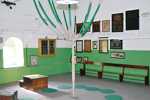 The
ringing room The
ringing room |
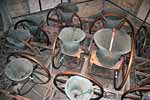 The bells The bells |
In addition to the main ring is the Sanctus bell. This measures 18.5", weights 1.0.20 (cwt.qr.lb). It carries no inscriptions or other marks, but indications are that it is very old.
Hand Bells
In 2001 an oak wall cabinet for the display and storage of the hand bells was acquired by the bell ringers with monies from tower projects by the Friends of St Mary’s.
There are two set of bells in the cabinet. The older set of 12 cup bells on the upper two rows were the gift of Squire William Fortrey of Kings Norton-by-Galby, presented to the ringers on the occasion of the ringing of 10,260 changes of Grandsire Caters in 1778.
The bells came into the possession of E H Lewis in the mid 20th Century through his brother-in-law, the Rev HST Richardson. It was the intention of them both that the bells should go back to St Mary’s Church Nottingham, where they could be sure they would be kept in the tower. Mr Lewis considering that this could now be done, returned the bells. They are placed in a glass fronted cupboard, in which there is a plate engraved:
| These bells once belonging to Lawyer William Doubleday Crofts and this cupboard were given by Edwin H. Lewis in memory of his brother-in-law Harold S.T. Richardson, Priest and bell ringer. |
In 1994 the modern set of 14 bells were donated by Joyce Bode, a St Mary’s ringer, in her will. These bells were made by the Whitechapel Bell Foundry in London.
The hand bells were rung at the entrance to the church in 1992 during the installation of the sound insulation.


